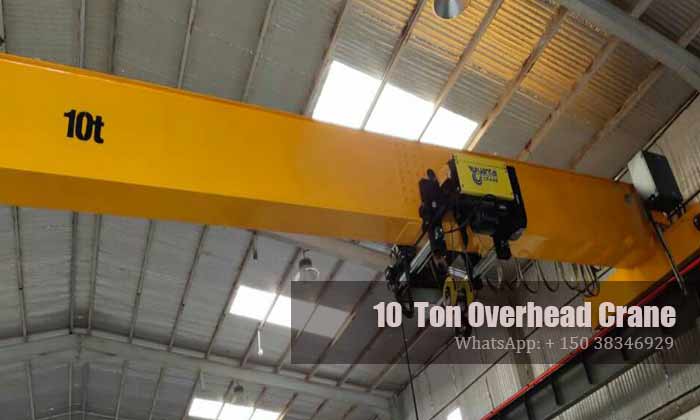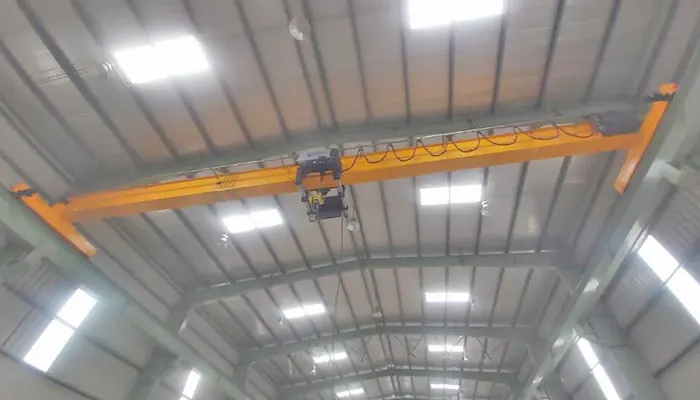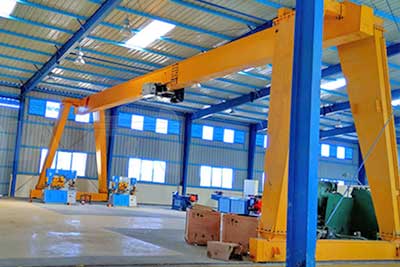10 Ton Overhead Crane Customized for Printing Industry
Custom 10 ton overhead crane for the printing industry, designed for precise, efficient material handling, improving workflow & safety. Get your design!
In the environment of industrial operations, the role of overhead cranes stands out prominently. These essential pieces of equipment play a crucial role in facilitating efficient and safe movement of heavy materials within manufacturing and processing facilities. Among the myriad of industries benefiting from their utility, the printing industry has specific requirements that necessitate customized solutions to optimize workflow and safety.
Importance of Overhead Cranes in Industrial Settings
Overhead cranes are indispensable in industrial settings due to their ability to handle heavy loads with precision and efficiency. Unlike traditional material handling methods, such as forklifts or manual labor, overhead cranes offer several distinct advantages:
- Efficiency: Overhead cranes significantly expedite the process of loading, unloading, and maneuvering heavy materials, reducing downtime and enhancing overall productivity.
- Safety: By lifting materials overhead and away from ground-level hazards, overhead cranes contribute to a safer working environment. This minimizes the risk of accidents and injuries associated with manual handling or alternative methods.
- Versatility: With various configurations and capacities available, overhead cranes can be tailored to meet specific operational needs across different industries, ensuring flexibility and adaptability.
Specific Focus: Custom 10 Ton Overhead Crane for the Printing Industry
The printing industry, known for its intricate processes and demanding operational requirements, benefits greatly from the precise capabilities of custom overhead cranes. The Custom 10 Ton Overhead Crane designed for this sector addresses unique challenges and enhances efficiency in the following ways:
- Handling Large Printing Equipment: Printing facilities often house bulky machinery and materials, such as printing presses and paper rolls, which require robust lifting solutions. The 10-ton capacity of the overhead crane ensures that these heavy items can be handled safely and efficiently during installation, maintenance, and relocation.
- Optimizing Space Utilization: Printing facilities are typically characterized by limited floor space. The overhead configuration of the crane allows for efficient material handling without occupying valuable ground-level area, thereby optimizing the layout and workflow of the facility.
- Enhancing Workflow: By streamlining material handling processes, the custom overhead crane reduces downtime and facilitates smooth operations. This is particularly crucial in the fast-paced printing industry, where timely production schedules and delivery commitments are paramount.
The introduction of a Custom 10 Ton Overhead Crane into the printing industry underscores the industry's commitment to enhancing operational efficiency and safety. By leveraging the crane's robust capabilities tailored to specific printing needs, manufacturers can achieve significant improvements in productivity and workplace safety. As technology continues to advance, the role of customized overhead cranes will remain pivotal in supporting the evolving demands of industrial sectors, ensuring sustainable growth and operational excellence.
Overview of Overhead Cranes
Overhead cranes are pivotal in industrial environments for their ability to efficiently lift and move heavy objects. They are characterized by their overhead structure, which allows them to traverse along a runway system installed overhead, typically within a factory or warehouse setting. These cranes are essential for handling tasks that involve lifting and transporting materials that are too heavy or cumbersome for manual methods.
Overhead cranes, also known as bridge cranes or overhead bridge cranes, are industrial machines that consist of a hoist (lifting mechanism), a bridge (which spans the width of the area being serviced), and one or more runways (parallel beams along which the bridge travels). The primary purpose of overhead cranes is to lift and move heavy loads horizontally and vertically with precision and efficiency. They are designed to handle materials in a way that maximizes safety, minimizes downtime, and optimizes floor space utilization.
Bridge Cranes: Also known as single-girder or double-girder cranes, bridge cranes are among the most common types. They are characterized by their overhead bridge that spans the width of the facility. Single-girder cranes have one girder beam supporting the hoist trolley, while double-girder cranes have two parallel girder beams for added stability and capacity.
Gantry Cranes: Gantry cranes are similar to bridge cranes but are supported by legs that run on fixed rails or wheels on the ground level. This configuration allows them to move along the ground as well as along the overhead runway, making them suitable for outdoor applications or facilities without overhead support structures.
Jib Cranes: Jib cranes consist of a horizontal arm (jib) that is mounted to a wall or a floor-mounted pillar. They are used for localized lifting tasks within a specific area and can rotate to provide coverage in a circular area around the mounting point.
Monorail Cranes: Monorail cranes consist of a single rail or beam along which a hoist trolley moves. They are ideal for applications where materials need to be transported along a fixed path, such as assembly lines or paint lines.
Each type of overhead crane offers distinct advantages depending on the specific requirements of the application, such as load capacity, span, height, and environmental factors. By selecting the appropriate type of overhead crane, industries can significantly enhance their material handling capabilities, streamline operations, and improve overall efficiency.
 10 ton overhead bridge crane for sale
10 ton overhead bridge crane for sale

Importance of Overhead Cranes in the Printing Industry
Overhead cranes play a crucial role in the printing industry, addressing specific needs and providing substantial benefits that contribute to operational efficiency and safety.
Specific Needs in the Printing Industry that Require Overhead Cranes
- Handling Heavy Equipment: Printing presses and associated machinery in printing facilities are often large and heavy. Overhead cranes with substantial lifting capacities, like the Custom 10 Ton Overhead Crane, are essential for safely installing, maintaining, and relocating these equipment pieces.
- Transporting Paper Rolls: Paper rolls used in printing processes can be bulky and difficult to handle manually. Overhead cranes provide a reliable method for lifting and moving these rolls, ensuring efficient material flow throughout the production process.
- Accessing Elevated Storage: Printing facilities often utilize elevated storage areas for materials and finished products. Overhead cranes with sufficient lifting height enable efficient access to these storage locations, optimizing space utilization within the facility.
Benefits of Using Overhead Cranes in Printing Facilities
- Enhanced Efficiency: Overhead cranes streamline material handling operations by significantly reducing the time and effort required to move heavy materials. This efficiency leads to faster production cycles and improved overall workflow.
- Improved Safety: By lifting materials overhead, overhead cranes minimize the risks associated with manual handling, such as strains, injuries, and accidents. This enhances workplace safety and reduces the likelihood of damage to valuable equipment and materials.
- Optimized Floor Space: Printing facilities often have limited floor space, making efficient use of vertical space crucial. Overhead cranes operate on overhead runways or gantries, freeing up floor space for other operations or equipment.
- Versatility: Customizable features of overhead cranes allow them to be tailored to specific tasks and layouts within printing facilities. Whether it's precise positioning of equipment or handling materials of varying sizes and weights, overhead cranes provide versatility to adapt to changing operational needs.
- Cost-effectiveness: While initially an investment, overhead cranes offer long-term cost savings through improved productivity, reduced downtime, and minimized maintenance costs compared to manual or less efficient handling methods.
In conclusion, overhead cranes are indispensable tools in the printing industry, addressing specific operational needs and providing substantial benefits such as enhanced efficiency, improved safety, optimized space utilization, versatility, and long-term cost-effectiveness. Their ability to handle heavy loads with precision and reliability makes them a cornerstone of efficient material handling in modern printing facilities.
Case Study: Implementation of Custom 10 Ton Overhead Crane in a Printing Facility
ABC Printing Company, located in City X, specializes in large-scale printing services for various industries including publishing, packaging, and advertising. The facility spans over 20,000 square meters and houses state-of-the-art printing presses, paper handling equipment, and finishing stations. With a robust production schedule and stringent quality standards, efficient material handling is critical to meet customer deadlines and maintain operational excellence.
Challenges Faced Before the Installation of the Overhead Crane
Prior to the installation of the Custom 10 Ton Overhead Crane, ABC Printing Company faced several challenges in their material handling processes:
- Manual Handling Limitations: Heavy equipment and paper rolls were predominantly moved using manual labor or outdated equipment, leading to inefficiencies and increased risk of workplace injuries.
- Space Constraints: The facility's layout and limited floor space posed challenges for maneuvering and storing large printing equipment and materials, impacting workflow efficiency.
- Safety Concerns: Manual lifting and handling of heavy loads posed safety risks to workers, with potential for accidents and injuries.



Specifications of the Custom 10 Ton Overhead Crane
The Custom 10 Ton Overhead Crane designed for the printing industry is tailored to meet specific operational requirements, providing robust capabilities for efficient material handling.
- Crane Capacity: 10 Ton
- Capacity: The crane is capable of lifting loads weighing up to 10 tons (10,000 kilograms). This substantial capacity is essential for handling heavy equipment and materials typically found in printing facilities, such as large printing presses and paper rolls.
- Crane Span: 13.949 Meters
- Span: The crane spans a distance of 13.949 meters horizontally. This wide span allows the crane to cover a significant area within the printing facility, providing extensive reach for loading and unloading materials from various locations.
- Lifting Height: 62 Meters
- Lifting Height: With a lifting height of 62 meters, the crane can efficiently lift materials to elevated positions within the printing facility. This height is sufficient for accessing elevated storage areas or loading materials onto machinery without obstruction.
- Power Supply: 400V 50Hz 3P
- Power Supply: The crane operates on a standard electrical supply of 400 volts, 50 hertz, three-phase (400V 50HZ 3P). This power requirement ensures reliable and consistent operation, supporting continuous productivity in the printing operations.
These specifications highlight the Custom 10 Ton Overhead Crane's capability to handle heavy loads across a wide span and lift materials to significant heights, all while maintaining operational reliability through a standardized power supply. This custom crane configuration is specifically engineered to enhance efficiency and safety within the dynamic environment of the printing industry, aligning with industry standards and operational needs.
Detailed Implementation Process of the Custom Crane
The implementation of the Custom 10 Ton Overhead Crane at ABC Printing Company involved a systematic approach to meet specific operational requirements:
- Assessment and Planning: Engineers conducted a thorough assessment of the facility's layout, workflow, and material handling needs. Detailed planning ensured the crane's design and installation would optimize efficiency and safety.
- Customization and Fabrication: Based on the assessment, the crane was customized with a 10-ton lifting capacity, 13.949-meter span, and 62-meter lifting height. Fabrication adhered to industry standards and incorporated safety features tailored to the printing environment.
- Installation and Testing: A team of certified technicians installed the overhead crane on existing support structures within the facility. Rigorous testing and calibration ensured the crane operated seamlessly and met performance expectations.
- Training and Integration: Comprehensive training programs were conducted for operators and maintenance personnel to familiarize them with the crane's controls, safety protocols, and maintenance requirements. Integration with existing workflows ensured minimal disruption to ongoing operations.
Benefits Observed Post-Installation
Since the installation of the Custom 10 Ton Overhead Crane, ABC Printing Company has experienced significant improvements across various aspects of their operations:
- Enhanced Productivity: The crane's ability to swiftly and safely handle heavy equipment and materials has streamlined production processes, reducing downtime and optimizing workflow efficiency.
- Safety Enhancements: By minimizing manual handling and lifting, the overhead crane has enhanced workplace safety, reducing the risk of injuries and improving overall employee well-being.
- Space Optimization: Vertical lifting capabilities have optimized floor space utilization, allowing for better organization of materials and equipment within the facility.
- Cost Savings: Reduced maintenance costs associated with manual handling equipment and improved operational efficiency have contributed to long-term cost savings.
- Customer Satisfaction: Improved productivity and reliability in meeting deadlines have bolstered customer satisfaction, enhancing ABC Printing Company's reputation in the industry.
In conclusion, the implementation of the Custom 10 Ton Overhead Crane at ABC Printing Company exemplifies its transformative impact on operational efficiency, safety, and overall productivity. By addressing specific challenges and leveraging advanced material handling capabilities, the crane has positioned ABC Printing Company for continued success in a competitive market landscape.
10 Ton Bridge Crane Project Planning and Execution
Implementing a Custom 10 Ton Overhead Crane in the printing industry involves meticulous planning, collaboration between stakeholders, and adherence to a structured timeline to ensure successful integration into existing operations.
Steps Involved in Designing and Customizing the Overhead Crane for the Printing Industry
- Needs Assessment: Engineers and project managers conduct a thorough assessment of the printing facility's layout, operational workflows, and specific material handling requirements. This step identifies key challenges and opportunities for improvement.
- Customization Specifications: Based on the assessment, detailed specifications are developed for the overhead crane, considering factors such as lifting capacity (10 tons), span (13.949 meters), lifting height (62 meters), and power supply requirements (400V 50Hz 3P). These specifications ensure the crane meets the facility's unique operational needs.
- Engineering Design: Crane manufacturers and engineers collaborate to design the crane system. This includes structural design, selection of materials, integration of safety features (e.g., limit switches, overload protection), and consideration of environmental factors (e.g., temperature, humidity).
- Fabrication and Assembly: Once the design is finalized, fabrication begins according to industry standards and regulatory requirements. Components are manufactured, assembled, and tested to ensure quality and reliability.
- Installation Planning: Detailed installation plans are developed, considering logistical challenges, safety protocols, and minimal disruption to ongoing operations. Site surveys and preparations ensure the crane can be installed efficiently on existing support structures or new installations.
- Testing and Commissioning: Rigorous testing and commissioning processes are conducted to verify the crane's functionality, safety features, and adherence to performance specifications. This phase includes load testing, alignment checks, and operational simulations.
Collaboration Between Crane Manufacturers, Engineers, and Printing Industry Experts
- Consultation and Requirements Gathering: Close collaboration between crane manufacturers, structural engineers, electrical engineers, and printing industry experts ensures that the crane design aligns with operational needs and regulatory standards.
- Design Review and Approval: Iterative design reviews involve feedback from all stakeholders to refine the crane's specifications and functionality. This collaborative approach enhances the crane's suitability for the printing environment.
- Installation and Integration: Throughout the installation process, continuous communication and coordination among stakeholders facilitate smooth integration of the crane into the facility's workflow. Training programs for operators and maintenance personnel ensure comprehensive understanding of the crane's operation and safety protocols.
Timeline and Milestones of the Project
- Initial Planning and Assessment: Conduct needs assessment, define project scope, and establish timelines for design, fabrication, and installation. Duration: 1 month.
- Design and Customization: Develop detailed specifications, engineering design, and customization of crane components. Duration: 2-3 months.
- Fabrication and Assembly: Manufacture crane components, assemble and test subsystems, ensure compliance with safety standards. Duration: 2-3 months.
- Installation and Commissioning: Prepare site, install crane system, conduct testing, and commissioning to verify performance. Duration: 1-2 months.
- Training and Handover: Provide training for operators and maintenance staff, finalize documentation, and hand over the operational crane system to the printing facility. Duration: 1-2 weeks.
- Post-Installation Review: Conduct post-installation review, address any operational issues, and ensure ongoing support for maintenance and optimization. Duration: Ongoing support.
By adhering to these structured steps and fostering collaboration among stakeholders, the implementation of the Custom 10 Ton Overhead Crane in the printing industry ensures a seamless transition to enhanced material handling capabilities, operational efficiency, and safety within the facility.
Conclusion
In conclusion, the integration of custom overhead cranes, such as the 10 Ton Overhead Crane, into the printing industry represents a significant enhancement in operational efficiency, safety, and overall productivity. This case study highlights the transformative impact of advanced material handling solutions tailored to meet specific industry needs.
Custom overhead cranes offer numerous benefits to printing facilities:
- Enhanced Efficiency: By streamlining material handling processes, overhead cranes reduce downtime, improve workflow efficiency, and accelerate production cycles.
- Improved Safety: Overhead cranes minimize the risks associated with manual handling, promoting a safer work environment and reducing the likelihood of workplace injuries.
- Optimized Space Utilization: Vertical lifting capabilities optimize floor space utilization, allowing for better organization of materials and equipment within the facility.
- Versatility: Customizable features cater to specific operational requirements, enabling precise handling of heavy equipment, paper rolls, and other materials essential to printing operations.
- Cost-effectiveness: Despite initial investment costs, overhead cranes offer long-term cost savings through improved productivity, reduced maintenance expenses, and enhanced operational efficiency.
Overhead cranes are indispensable tools in industrial sectors like printing, where efficient material handling is essential for maintaining competitive advantage and meeting customer demands. As printing technologies advance and production volumes increase, the role of custom overhead cranes in optimizing operational processes and ensuring workplace safety becomes increasingly critical.
By investing in tailored overhead crane solutions, printing facilities not only enhance their operational capabilities but also position themselves for future growth and sustainability in a dynamic marketplace. The ongoing evolution of overhead crane technology promises continued advancements that will further enhance efficiency, safety, and overall productivity across industrial sectors globally.





